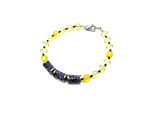Gemstone Index: Ruby
From royal crowns to Dorothy's slippers to, of course, delicious jewelry, the ruby is a most desirable gemstone. Its hardness, durability, luster and rarity are among the world's finest, and its blazing red color is beyond compare. Ruby is the red variety of the corundum (aluminum oxide) mineral, a family that also includes sapphire, and takes its name from the Latin rubeus or ruber, meaning "red." Corundum (which sapphires and rubies are comprised of) is the second-hardest natural mineral known to mankind. Pure corundum is colorless; the presence of chromium impurities creates the fiery-colored stone known as ruby, and corundum of any other color is sapphire. Blue sapphires are simply called sapphire, and all other colors (except ruby) are preceded with their color (such as pink sapphire). Ruby is the July birthstone and is mined only rarely around the world. Millions of years ago, as chromium was giving rubies their wonderful color deep inside the Earth's core, it also was causing a multitude of fissures and tiny irregularities inside the crystals. Only a precious few ruby crystals could grow undisturbed to considerable sizes and crystallize to form a perfect gemstone.
Color is the ruby's most important feature: transparency is secondary. Inclusions, therefore, don't affect the gemstone's quality (unless they decrease the transparency), but rather are the gemstone's fingerprints. However, imperfections and impurities can be removed by controlled heating; some rubies have fissures or surface breaks that are filled with a glasslike by-product of the heating process. Ruby was the first mineral to be produced by commercial synthesis and dates to the 1880s. Many people have brought family heirlooms for insurance appraisals only to be told that their "gemstone" was not natural. Many rubies on the market are synthetic, but only experts can distinguish between natural and synthetic. Despite their superb hardness, natural rubies are still subject to chipping and fracture if handled roughly. When our ruby beads are cut in China, they are cut and drilled with more precision, but often are more opaque. When our ruby beads are cut in India, they are so generally cut from higher quality rough, but irregularities in shape and hole size should be expected.
For many years, India was considered the classical country of rubies. The literature of India contains a rich and varied knowledge of the stone covering 2,000 years. However, the ruby mines of Myanmar (formerly Burma) are older than history. Stone Age and Bronze Age mining tools have been found in Myanmar's Mogok Valley. The ancient Romans considered it the stone of the war god Mars, and in the Bible, Job says, "The price of wisdom is above rubies." Rubies are generously represented in crowns and scepters in the royal jewels of many nations. The stone has been called the "king of precious stones" or the "queen of gemstones." The symbol of devotion and love for centuries, many attribute rubies the power to stimulate sexual desire and energy. Because of their color, rubies are said to be very healing. Physical wounds and blood disorders, as well as emotional and spiritual wounds, are often treated with this gemstone. As a tool for meditation, rubies are extremely powerful for healing chakras (especially the first chakra), and they are said to bless the wearer with health, wealth and wisdom. The gemstones are found in Myanmar, Sri Lanka, Cambodia, Pakistan, India, Thailand, Madagascar, Zimbabwe, the U.S.A. (North Carolina), Afghanistan, Kenya, Tanzania and Kampuchea.
Our Bead Blog
-
Sparkle & Shine Fabulous Bracelet
Jul 23rd 2024Created by: Guest Designer Deb FlorosSuggested Supplies 3 #05-950-LAMCPS8S PRESTIGE 5950 8mm Light
-
Show Some Love Charm Bracelet
Jul 23rd 2024Created by: Guest Designer Deb FlorosSuggested Supplies 1 #40-412-7 Antiqued Copper Plated Curb Cha
-
Joyful Summer Vinyl Bead Jewelry
Jun 21st 2024Created by: Guest Designer Deb FlorosSuggested Supplies 1 #22-535-74 Trade Beads, Vinyl, Heishi, 6m



